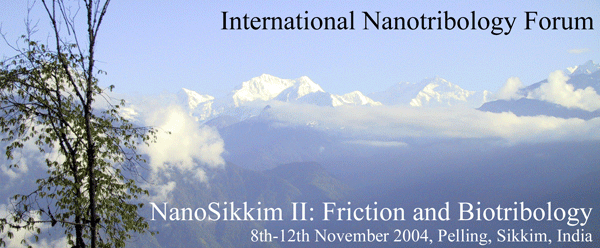Human beings have been trying to tame friction to their advantage since they began to interact with nature
to make a living. It is surprising that we have, even today, understood very little of the mechanisms that give
rise to this baffling phenomenon. With the advancement in the associated instrumentation there has been a spate
of novel experiments in the last decade or so, spanning the range from nanometers to centimeters.
There has also been corresponding advancement in the simulation of dynamic phenomenon at these scales.
Taken together they have opened up a fresh debate that will help to understand
friction from the standpoint of atomic-scale processes.
On the micro scale, friction has been conventionally dealt with as the energy dissipative
mechanism between two solid surfaces moving relative to each other. The energy is mostly lost in
the form of heat and as work done in generating wear particles. The actual modes of dissipation
depend on the specific properties of the interacting materials.
The traditional way of treating friction had been mainly empirical. Following Amontons'
law, a lot of experimental data have been gathered to show how the friction coefficient depends on
the particular operating conditions. There have been few attempts to consolidate these data in the
form of a general theory using continuum mechanics. This is complicated by the fact that friction is
a result of many interacting processes such as geometric locking of two surfaces, elastic and plastic
deformations, wear, lubrication, and adhesion. All these processes occur at very different length
scales: on the nanometer scale, atomic and molecular interactions take place, the micrometer is the
typical length scale for real contact radii (the real contact area between two solids is usually orders
of magnitudes smaller than the apparent contact area and it is distributed over many individual
asperity contacts), and the largest tribological length scales are related to the stick slip motion of
tectonic plates resulting in earthquakes.
Assuming no-slip boundary conditions, the Reynolds equation has been solved to equate
frictional work done in a journal bearing to the energy dissipated in a viscous Newtonian fluid.
This has provided a powerful tool in the design of the bearings and other machine parts. However,
of late, the condition that exists at the liquid-solid interface has come under much scrutiny.
Additionally, some investigations have found that the properties of the confined fluid of a few
atomic layers are very different from those of the bulk.
It is the main challenge of modern tribology to develop a fundamental understanding of
friction, which allows us to bridge the different length scales and properly relate the atomistic
processes with the macroscopically observed phenomena. It is important to stress that the
microscopic origin of solid friction is in fact less obvious than it first seems: many simulations
erroneously predict that perfectly flat, crystalline surfaces in vacuum should display supralubricity
i.e., the frictional forces between the two solids is a drag force that vanishes in the limit of small
velocities.
Continuum-based Amontons' law and Coulombic concepts have been found to be
remarkably consistent in addressing a range of solid-solid contact problems. Nevertheless, it is still
not clear what the dissipative mechanisms are at the atomic/molecular level which, in aggregate,
give rise to such laws, especially when there is a third medium of a liquid or adsorbed molecules
present at the interface. This has been the focal point of debates that have tended to be
inconclusive.
This brings us to the following questions:
(1) Are we generating the right type of experimental data? (both macroscopic and microscopic)
(2) Are we constrained by the existing continuum theories?
(3) Is it possible to arrive at general theories at the molecular level, which could be extended to the macroscopic level?
Or
(4) Is it possible to modify existing or propose new continuum theories to accommodate nanoscopic experimental observations?
(5) How do we model the atomistic interactions of asperities to include the long-range elastic interactions between asperities?
(6) How does surface modification chemically and physically affect
the friction?
(7) Can we apply what we understand to frictional processes in biology and medicine or can we learn something from the way that nature deals with friction?
We would like the meeting to not only address these issues but also to set a general direction in which research efforts should be directed towards understanding the phenomena of friction at solid-solid and solid-liquid-solid interactions.
